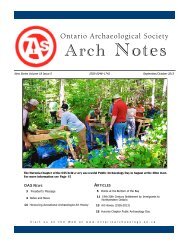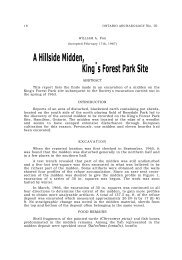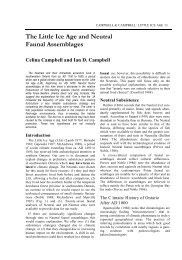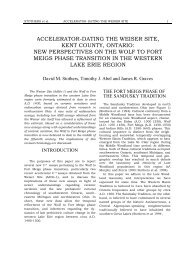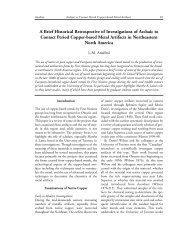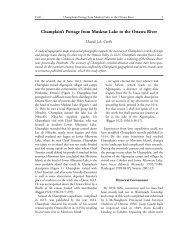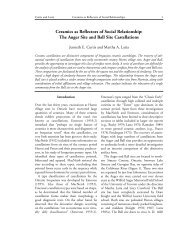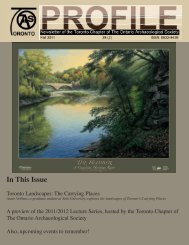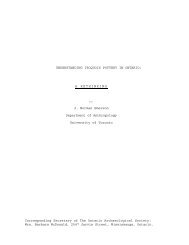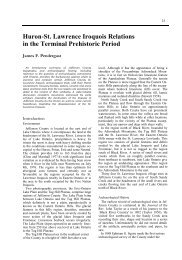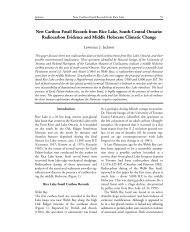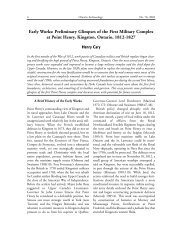oa 77-78 layout part 07 - Ontario Archaeological Society
oa 77-78 layout part 07 - Ontario Archaeological Society
oa 77-78 layout part 07 - Ontario Archaeological Society
- No tags were found...
Create successful ePaper yourself
Turn your PDF publications into a flip-book with our unique Google optimized e-Paper software.
62 <strong>Ontario</strong> Archaeology No. <strong>77</strong>/<strong>78</strong>, 2004Recreating Home? A Consideration of Refugees, Microstyles andFrilled Pottery in HuroniaAlicia L. HawkinsThis paper revisits explanations for the presence of large quantities of frilled pottery at certain seventeenthcentury Wendat sites. It considers the ways in which the traditional Wenro refugee explanations are problematic.An analysis of decorative microstyles is outlined, with the g<strong>oa</strong>l of determining whether pots fromBeGx-25 (identified in the literature as Ossossané village), both with and without frills, were decorated bythe same potters. The relationship between forced migration and material culture is examined and a secondexplanation for the presence of frilled pottery is offered. The results of this analysis are considered inlight of what is known of how contemporary refugees manipulate material culture.IntroductionOne of the themes in contact-period Wendatarchaeology has been the identification of villagesand missions documented in the Jesuit Relations(for a review of such work see Latta 1985). Inwestern Huronia, the work of Kidd (1953) andRidley (1947) served to identify a village referredto as Ossossané, occupied from 1623 to 1634,and the associated 1636 ossuary. It should benoted, however, that Sagard and Le Caron referto the village of this period as Quieuindahian(Trigger 1976). While Latta (1985) argues thatidentification of Jesuit missions associated withdifferent Wendat tribes can be a useful archaeologicaltool for interpretation and study of earliermaterial culture, some other archaeologistshave used identification of sites and their traitsmainly as confirmation of the historical record.An example of such work is Ridley’s (1964) identificationof the Ossossané village(s) and the linkhe made between frilled pottery from that siteand from the Edwards site (BeGx-27) withWenro refugees (Ridley 1973). Archaeologiststend to accept the latter hypothesis (Garrad andSteckley 1998; Hawkins 1992; Jackson andMerritt 20<strong>07</strong>; MacDonald 1991), but it does notaccount for all of the evidence (Hawkins2001:32-33). Furthermore, in the time sinceRidley’s publication, contact period studies of theWendat have moved from confirmation of historyas understood from documentary sources tointerpretation and explication of the past(Trigger 2001). Whether the pottery was producedby Wenro refugees or not, the appearanceof a large quantity of pottery with unusual decorationholds potential for more detailed understandingof the dynamics of Wendat society inthe early to mid-seventeenth century. This paperoutlines analysis aimed at determining if the decoratorsof typical Wendat pottery were also thedecorators of unusual, frilled pottery, andexplores why new styles may have been introducedand adopted.BackgroundThe Wenro migration question is outlined indetail elsewhere (Hawkins 1992, 2001), and willbe briefly discussed. According to the JesuitRelations (Thwaites 1896-1901:15:159, 17:25-29), a group of over 600 refugees migrated toHuronia in 1639, having negotiated the move inadvance. The group arrived first at Ossossanéand included many people who were ill(Thwaites 1896-1901:17:25-29). Interpretationsof the Jesuit Relations and archaeological remainshave led researchers to place the Wenro homelandin the Niagara frontier and other locationsin New York state (Bradley 1987; Niemczycki1984; White 1961,19<strong>78</strong>) (Figure 1).In 1973, Frank Ridley published a descriptionof material recovered from the Edwards site andfrom BeGx-25, the site that he identified as theOssossané village of 1623-34. These sites bothcontain high proportions of pottery with basal
Hawkins Refugees, Microstyles and Frilled Pottery in Huronia 63Figure 1. Map showing possible Wenro homeland locations based on interpretation of historical documents.collar modification (hereafter referred to as“frilled pottery,” although notched, frilled andnocked pots are all referred to using this term)and pottery with decorative rim motifs differentfrom others common to contemporary sites inHuronia. Ridley suggested Wenro migrants producedthe frilled pottery, which occurs in highproportions. Although not explicitly stated, heassumed that pottery decoration reflected theethnic identity of the potters. He believed thatthe Wenro came from somewhere near theSeneca (Ridley 1973).Following up on Ridley’s work, I conductedstylistic analyses of material from a number ofWendat sites: Leonard (BeGx-22), Ellery (BdGx-8), BeGx-25, Charity (BeHb-4), and Orr Lake(not Bordenized) and chemical analysis of materialfrom BeGx-25 and Leonard (Figure 1). All ofthese collections, even the ones with few frilledpots, show considerable variability in the decorationof the upper rim; these include the methodof fashioning the frill as well as the nature andapplication of upper rim decoration. These rimfocusedanalyses did not entail examining thepots for potentially informative differences inpaste composition, vessel size, vessel shape, bodydecoration or function. The results suggest productionby more than one individual and/orexperimentation with frilling as decoration. Thecompositional analysis indicates that frilled potsand those with more typical decoration do notdiffer chemically (Hawkins 2001:28-32). Pottery
64 <strong>Ontario</strong> Archaeology No. <strong>77</strong>/<strong>78</strong>, 2004from the Gen<strong>oa</strong> Fort site in New York State,however, has a different chemical signature thanthat from <strong>Ontario</strong> (Hawkins 2001:28-32). Iinterpret this to indicate that the frilled potterywas made from the same local clays as pots decoratedin more typical fashions.Production of pottery locally in Huronia by anumber of individuals appears consistent withwhat we would expect from a refugee population.However, in the time since Ridley’s publication,the archaeological records in <strong>Ontario</strong> andNew York state have been more fully investigatedand some possible problems with Ridley’shypothesis arise. Furthermore, refugee studieshave emerged as a discipline (Ager 1999; Black2001) and may provide models for how forcedmigrants may alter their material culture as aconsequence of displacement.Problem One: Large Amounts of Frilled Potteryand No Clear HomelandIf frilled pottery is a marker of Wenro-ness, then,unless explained further, we would expect to finda Wenro homeland with frilled pots similar tothose found in Huronia. Furthermore, if Wenropotters continued their potting traditions in theirnew home, we would expect that the proportionof frilled pottery at sites in their homeland wouldbe greater than at Wendat sites where Wendatwomen would, presumably, produce pots in theirtraditional styles. Sites in Huronia with frilledpottery include BeGx-25, Edwards and OrrLake, among others. According to Ridley (1973),72 percent of the pots from Edwards are frilledand when he includes high collared material inhis calculations, the percent of “foreign” potteryat Edwards reaches 91 percent. The high proportionsof frilled ceramics may be a product of samplingat Edwards. However, this is unlikely to bethe case at BeGx-25. Examination of excavationreports and provenience information on sherdsshows that Ridley excavated two main areas 100feet a<strong>part</strong>, and frilled pottery was found in bothof these places (Hawkins 2001; Ridley 1964,1965). Ridley (1975) re-located the Orr Lakesite, but the collections at the Royal <strong>Ontario</strong>Museum are the product of other collectors(Kidd 1950) and were made long before Ridleyput forward his Wenro refugee hypothesis.Frilled pottery accounts for 18 percent of thesherds in the assemblage, while high collaredsherds make up another five percent. This is aconservative estimate of the proportion of frilledsherds because children’s pots and castellationswere included when making the calculation.However, it should be noted that this is the proportionof frilled sherds at Orr Lake, not the proportionof frilled pots. Sampling may account forhigh proportion of frilled pots from Edwards,but it seems unlikely that in the other cases excavatorschanced upon middens with unrepresentativelyhigh amounts of frilled pottery.The suggested location of the New York homelandof the Wenro is based on interpretation ofdocuments and archaeological evidence (Figure1). According to White (1961:37) the most likelylocation of the Wenro prior to 1639 is in theNiagara frontier region, between the Seneca andthe Attiwandaronk (Neutral confederacy). Sitessuch as Silverheels, Kleis and Ellis have percentagesof frilled ceramics that range from 8 to 19percent (Bursey, personal communication 2005).Englebrecht (personal communication 2001)reports that between 13 and 25 percent of sherdsfrom sites east of the Niagara River and south ofLake Erie fall into the Seneca Barbed and Gen<strong>oa</strong>Frilled types. Although Noble (1980:52) reported“a sizeable quantity of Gen<strong>oa</strong> Frilled pottery” atthe Thorold site on the west side of the Niagarariver, only eleven frilled pots (about 6 percent) arepresent in the assemblage and several of these areso similar in decorative motif and method ofmanufacture that it is likely a single individualproduced them. The percentage of frilled pots inthis collection is an estimate because time constraintsdid not allow me to group typical sherdsinto pots. Neither the decorative motifs nor themethod of manufacture of frill on the Thoroldpots is similar to that known from Wendat sites(Figure 2). In sum, if Wenro refugees producedfrilled pots in the same proportions in <strong>Ontario</strong> asthey did in New York, then we would expect tofind only small proportions of the Ontari<strong>oa</strong>ssemblages composed of such pots. This is notwhat we find. Ridley acknowledges this problemwhen writing about Orr Lake:
Hawkins Refugees, Microstyles and Frilled Pottery in Huronia 65Figure 2. A comparison of thefrilled pottery from Thorold(left) with that from Ossossané(right).As with several historic Huron sites, thestrange Seneca-like pottery, that seemsintrusive, appears in considerable quantitiesand is now attributed to the Wenro,who migrated to Huronia in the year1639. The quantities of such pottery onthese sites seems unduly copious, sincethe Wenro migration consisted of only sixhundred souls. However the Wenro weresaid to have been impoverished and probablyhad to continue the use of their ownhand made clay vessels, whereas theirHuron hosts would be enjoying the use ofEuropean brass kettles and trade goods incomparable prosperity. (Ridley 1975: 6)Ridley’s explanation does not account for theethos of sharing among the Wendat (Trigger1990:48), nor for the fact that brass kettlesappear to have been used in ritual contexts and asa source of raw material (Anselmi 2004).Problem Two: Different Types of FrillingFrilling of pottery from Wendat sites differs significantlyfrom frilling of pottery from Thorold onthe Niagara peninsula, and from Haudenosaunee(League of Five Nations) sites in the Finger Lakesdistrict (MacNeish 1952; Niemczycki 1984; Wray,et al. 1991). Examination of pots in the RochesterMuseum of Science showed that, for specimensfrom the Finger Lakes, decoration of the collar ismore common, includes horizontal motifs, maybe more complicated and sometimes includesdecoration on the frill or barb itself. The frillsand barbs are more widely spaced. Frilled potsfrom Thorold differ from those found at Wendatsites in that they have more complicated designson the collar and the frills appear to have beenmanufactured mainly by notching, rather thanmodelling (see Figure 2). If the Wenro camefrom somewhere in the Niagara frontier or upperNew York state area, and brought with themtheir pot decorating traditions, we would expectto find examples of complicated designs on thecollars of frilled pots from Wendat sites, and wemight expect to see examples of frilling usingsimilar methods to those found in the Niagarafrontier or New York state. Although the lack ofsome of these elements might be explained bythe “founder effect,” one wonders why none ofthe frilled pots from Thorold were similar to thepots found at Wendat sites.Problem Three: The Wide Distribution of CeramicDecorative ElaborationsRidley’s hypothesis that Wenro migrants toHuronia produced frilled pottery does notaccount for the widespread nature of a variety ofelaborations in decoration, including frilling,which occurs in the early to mid-seventeenthcentury through the Northeast. As outlined byLizee (1995), frilling and notching of collars,castellations, high collared triangular plat motifs,and effigy decorations occur through much ofthe Northeast at this time. It is noteworthy thatother elaboration types do not co-occur withfrilling on the same vessel: I have found no examplesof castellated frilled sherds, high-collaredfrilled sherds, or frilled sherds with effigy decorations.MacNeish (1952:52) associates Gen<strong>oa</strong>
66 <strong>Ontario</strong> Archaeology No. <strong>77</strong>/<strong>78</strong>, 2004Frilled pottery with the contact-period Cayugaand noted that it “has no antecedent in theCayuga sequence, and its ancestral or developmentalpredecessor is unknown.” De Orio(1980:<strong>77</strong>), a number of years later, also indicatesthat frilled pots occur “for either the first time orin larger quantities…on historic sites.” An exampleof such a site is Gen<strong>oa</strong> Fort, which he estimatesdates to A.D. 1600-1620. This suggeststhat this method of decoration may be as much aseventeenth century innovation in theHaudenosaunee area as it is in Huronia.Similarly, the Susquehannock frilled pot type,Blue Rock Valanced, becomes more commonafter A.D. 1600 (Kent 1980:103).The widespread nature of frilling and otherelaborations was remarked upon by Kent, as longago as 1979:Purely Seneca or Cayuga grit-tempered vesselsare occasionally found at Susquehannocksites. Similarly, a few shell-temperedSusquehannock pots occur in sites of the former.In view of their obviously different preferencesfor tempering materials, the traveldistance between the two areas, and the frequentconflict between them, we are struckby the remarkable similarity between certainSeneca-Cayuga pottery types and those ofthe Susquenhannocks. Schultz Incised…andIthaca Linear (and in some cases CayugaHorizontal), except for their temper differences,often appear indistinguishable fromone another. The same is true for Blue RockValanced and Gen<strong>oa</strong> Frilled. (Kent1980:103)Although the presence of frilled pottery in theSusquehannock area may lead researchers to suggestthat frilled pots and/or Wenro originatedthere, in the Susquehannock area the appearance offrilling also dates to the early seventeenth century.In the case of Susquehannock frilled pottery,one can make an argument on technologicalgrounds that the pots are made locally and are notimports. While Bursey (personal communication2005) puts forward an intriguing explanation forthe widespread occurrence of frilling that relatesto trade patterns, the fact that Susquehannockfrilled pots are shell tempered, while Seneca andCayuga ones are grit tempered suggests differentchâines opératoires and, consequently, that the makersof Susquehannock frilled pottery are not simplytransplanted Wenro. Furthermore, the trade networkexplanation does not explain the widespreadnature of other types of elaborations cited by Lizee.Problem Four: Which Ossossané is BeGx-25?The Jesuit Relations clearly place the Wenro migrationat 1639. In the 1964 excavation report on hiswork at Ossossané, Ridley identified BeGx-25 asthe Ossossané village occupied between 1623 and1634. The geographic setting of the site served asthe main basis for this identification.If Ridley’s identification of the site is correct,however, why was the supposedly Wenro-producedpottery present in a village that dates tobefore their arrival? Although the Jesuit Relations(Thwaites 1896-1901:17:29) indicate that theWenro were given “the best places in the cabins,”it is possible that the site identification is correct,that the pots were produced by Wenro and thereason that they are found there is that therefugees occupied the abandoned village. Theoccupation dates of the site ought, however, to beclarified based on the glass bead chronology.ProblemIn light of these unresolved questions, other explanationsfor the appearance of filled pottery shouldbe considered. In doing so, I make the assumptionthat people actively manipulate material culture asa method of transmitting messages, often about theidentity of the producer or the user of the item(e.g., Hodder 1982:128-132; Wobst 19<strong>77</strong>). Thisperspective entails a consideration of the role ofpottery in everyday life when suggesting reasons forunusual decoration. Iroquoian people used pots forboth storage and food preparation, with ethnohistoricaccounts clearly indicating the use of clay potsfor cooking (Parker 1983; Waugh 1973). Whilestorage vessels may have been located in placeswhere they were not seen regularly, cooking vesselswould have been visible and important in both thedaily lives of longhouse inhabitants and in hostingof guests (Parker 1983). Such vessels would have
Hawkins Refugees, Microstyles and Frilled Pottery in Huronia 67carried decoration deemed appropriate by thepotters and users of the pots. Johnson (1999)argues that because of the visibility of pots andthe importance of food in Mohegan ritual andpolitical negotiation, one of the important considerationsfor potters would have been the socialinformation that the pot would carry. Pots wouldhave had a similar role in the Wendat life and, inlight of this, other explanations for the high proportionsof frilled pottery on Wendat sitesrequire consideration. Four possible explanationsare:1. Wenro refugees were present at thesites in question and did producefrilled pottery. Possibly they also camefrom a homeland in the Niagara frontierregion. The reason for the inflatedproportion of frilled pottery in<strong>Ontario</strong> compared with sites in theNiagara frontier is that refugee womenchose to emphasize a distinctive aspectof their material culture to underscoretheir different identity.2. Wendat potters produced the frilledpottery. Although archaeologists frequentlyassociate Wendat women withthe domain of the longhouse and thevillage, and men with the worldbeyond the village, at least one historicaldocument indicates that Iroquoianwomen did travel (Bogaert 1988).Thus, Wendat women may have hadopportunities to see the pottery stylesof people living south of the Lake<strong>Ontario</strong> themselves. “Captive brides,”although I do not consider them to bethe producers of all frilled pottery inHuronia, may also have showed ordescribed to Wendat women the stylesof their pots.3. A group of people not documented inthe Jesuit Relations joined the Wendatsometime before 1634, bringing withthem their pottery decoration. Possiblythese new designs were observed andreplicated by Wendat potters.4. Frilling, along with other forms of elaborationin decoration, had an indigenousWendat origin, possibly inspiredby the different material culture ofEuropeans with whom they interacted.This explanation requires significantcommunication amongst groups in theNortheast.If we allow that Wendat women produced frilledpottery, we must consider why they might havedone so. Iroquoian women had, and have today, asignificant role in political life (Trigger 1990).Frilling and notching is widespread in theNortheast in the early to mid-seventeenth century,being known from sites of the Susquehannock(Kent 1980), Mohegan-Pequot, Narragansett andWampan<strong>oa</strong>g (Goodby 1998; Lizee 1995), andHaudenosaunee (MacNeish 1952). Geographically,the closest makers of such pottery are theHaudenosaunee, specifically the Seneca andCayuga, people with whom the Wendat were warringin the seventeenth century. While frilled potterydoes not, in MacNeish’s (1952: 52) opinion,have predecessors in Cayuga territory and thus itsappearance there may be coeval with the appearancein Huronia, other pottery with basal collarmodification does. Why, then, might Wendatwomen have made pots in the style of their enemies?Goodby (1998) examines a similar issue in theMohegan-Pequot, Narragansett and Wampan<strong>oa</strong>gtribal areas in present-day New England. Likethe Iroquoian-speaking groups in <strong>Ontario</strong> andNew York state, these three groups spoke closelyrelated languages and followed the same subsistencestrategy (Goodby 1998:163). As a result ofcolonization during the seventeenth century,relations among these three groups were tenseand marked by war and murder (Goodby1998:164-165). At the same time, however,social ties between the members of the threegroups persisted. Goodby’s (1998: 168-175)analysis of ceramics from Narragansett andWampan<strong>oa</strong>g sites showed that they did not differstylistically or technologically. The formation oftribal boundaries in New England occurs at thebeginning of the seventeenth century (Goodby
68 <strong>Ontario</strong> Archaeology No. <strong>77</strong>/<strong>78</strong>, 20041998). In <strong>Ontario</strong>, archaeologists have tended toextend the tribal designations known from seventeenthcentury ethnohistoric writing (Wendat,Attiwandaronk) backward to the fifteenth century.However, archaeologists now acknowledge thatthese confederacies may be relatively recent politicalgroupings (Ferris and Spence 1995:115).Goodby (1998:76) proposes, with respect tothe Narragansett and Wampan<strong>oa</strong>g, that:…there was an important debate ongoingduring the seventeenth century about thenature of relations between native peoples.…[C]eramic style was used by womenin a debate over the unity among nativepeoples…arguing through their expressionsof unity in ceramic design that unity amongnative peoples was a desired social end.Heidenreich (1990:489) points out that a recurringtheme in the Iroquois wars was the unificationof all Iroquoian-speaking people into one nation.The possibility that Wendat women made frilledpottery (as well as high collared pots with triangularplat motifs) as an expression of pan-Iroquoian orpan-aboriginal identity and unity deserves furtherexploration, given both the outstanding problemswith the Wenro refugee hypothesis listed above andthe fact that this hypothesis treats Iroquoianwomen as active manipulators of material culture.Earlier examination of the frilling at BeGx-25showed that there is a great deal of variation in themethod of producing the frill (Hawkins 2001: 22-23), such as one would expect if potters were experimentingwith methods, or production was in thehands of a number of individuals, or both.MethodsWork by Martelle (2002) suggests that it may bepossible to identify individual Wendat potters.Thus, with a reasonably large ceramic collection,we may be able to determine whether potterswho made vessels with more typical Wendat decoration(collared and collarless vessels withoblique stamping and incising on the upper rimand lip) also made frilled pottery.Hill (19<strong>77</strong>) established the theoretical andmethodological basis for this type of analysis bydemonstrating that <strong>part</strong>icipants in experimentsconsistently varied in how they applied decorationthat they were asked to copy. Further, thework of these individuals could be sorted correctlyusing statistical analysis of a series of ratioscale measurements. Hill (19<strong>77</strong>), Martelle(2002), and Van Keuren (1994), among others,focus on variables of painted and incised orstamped decorative motifs to isolate individualmicrostyles. Such analyses employ small differencesin the nature of the motifs and their application,including the order of application of differentelements. In pots with little or no decoration,variables related to forming of the vesselhave been applied (Espenshade and Kennedy2002:230). These include the method of formingthe pot, shape of the foot, and the method ofproducing the lip.Such researchers often equate clusters of similarartifacts with individual artisans, as I do below.There are other explanations for similarity; forexample, in social contexts that prioritize conformitywe would expect variation between individualsto be slight. At the same time, this analysisdoes not attempt to group all of the materials thata person might produce because it is likely thatstylistic micro-variation could be affected by arange of factors: age, illness, weather, paste conditions,exhaustion, and even time of day. For thisreason, I attempt to isolate “analytical individuals,”who I assume represent individuals orsocially close individuals. The possibility remainsthat different clusters may include objects craftedby the same person at different times (e.g., PotterA may have produced pots in Clusters 1 and 3);however, for the purposes of this analysis thispossibility is set aside. Although ethn<strong>oa</strong>rchaeologicalinvestigation could provide insight on therange of variability in the work of a single artisan,cross-cultural variation is likely to be great.I undertook preliminary analysis using materialfrom the Leonard site, and this entailed measurementof a series of nominal, ordinal and ratioscale variables that were subsequently analysedstatistically. The results were less than satisfactory,likely because of the small collection used:resultant grouped sherds, when directly compared,included many dissimilar ones.
Hawkins Refugees, Microstyles and Frilled Pottery in Huronia 71Figure 5. Scatterplot showingthe relationship between theangle of the notch and the frillwidth to notch width ratio onfrilled undecorated pots.Numbers indicate the tentativemicrostyle each pot was assignedto (see Table 1). 6a is a pot withdecoration on the collar thatwas tentatively associated withmicrostyle 6. Microstyles 4, 9and 11 are not representedbecause the variables in questioncould not be measured onthose pots or the piece was toosmall for measurement.Figure 6. Dendrogram showing theresults of a cluster analysis of vesselsgrouped into tentative microstyles.
72 <strong>Ontario</strong> Archaeology No. <strong>77</strong>/<strong>78</strong>, 2004Table 3. Tentative microstyle assignments for frilled decorated pots from Ossossané.Microstyle No. Method of Basal Collar ModificationNo. of Pots14 Impressed V-shaped notch, vertical angle on collar with only slight thickening at the base of the collar 115 Modelling or appliqué of frill angled to the extreme right 216 Modelled and pulled down 217 Substantial thickening of the collar base and notching 218 Modelled or appliqué and pushing of frills to the right 419 Modelling and pulling of frills forward 120 U-shaped notching of a thickened lip 121 Cutting away of triangular notch 222 Extreme thickening of the lip and V-shaped notching 123 Relatively shallow diagonal gash at low angle 424 Impressed V-shaped notch and pulling of clay downwards on right side 125 Appliquéd and modelled, pulled down 126 Pulled over or appliquéd thickened collar with V-shaped notches angled right 127 Shallow impressed U-shaped notch at slight left angle 128 Incised U-shaped notch at collar base angled right 1Figure 7. Tentative microstyle23 (relatively shallow diagonalgash at low angle).the plain collared pots, these variables groupedsome of the pots in the same clusters as the methodof production (Figure 8). However, combiningdecorated and undecorated frilled pottery resultedin less than satisfactory results for each of two clusteranalyses performed.At least two explanations exist for the lack ofoverlap between the plain and decorated frilledpots, if one accepts that the method of frilling is areasonable way to distinguish potters: (1) somethingin the application of decoration required orresulted in different methods of frilling; (2) differentpotters produced these two groups of pots. Iprefer the second hypothesis because it is difficult tosee how pots such as those shown in Figure 4 couldnot have been decorated by stamping or incising.The next step in the analysis entailed attemptingto determine whether frilled pots grouped withtypical pots. This proved challenging because thevariables used to group frilled pots are related tothe shape and method of production of the frill.Further, it is likely that variables of collar shape(e.g., lip orientation, lip shape and interior profile)would differ because of the presence of frills. Thenext analytical steps entailed:1. Exclusion of pots without decorationbecause after preliminary examinationthere appeared to be no decorativeattributes shared by plain frilled andnon-frilled pots. A detailed paste analysiscould be useful in future analysis;2. Division of pots without frilling intotwo groups: those with stamped decorationand those with trailed/inciseddecoration;
Hawkins Refugees, Microstyles and Frilled Pottery in Huronia 73Figure 8. Scatterplot showingthe relationship between theangle of the notch and thefrill width to notch widthratio on frilled decorated pots.Numbers indicate the tentativemicrostyle to which eachpot was assigned (see Table 3).3. Examination of each group for variationand development of a taxonomicclassification for the pots (Table 4). Theclasses may include pots made by morethan one potter, but the effort in classificationwas to continue subdividinggroups until the remaining pots formeda homogeneous group in style of decoration,excluding attributes of size.4. Classification of frilled pots using thissystem. Where they did not fit into apre-existing class, this was noted.Where they did fit into a pre-existingclass, the objects were compared todetermine whether similarities didexist, and whether other variables, notconsidered in the classification, hadthe same values.Pots decorated by stamping are a minority ofboth the standard Wendat pots and the frilled pots.Stamped pots included those with symmetrical V-shaped grooves and those with asymmetricalTable 4. Example of the taxonomic classification of decorative microvariation.Attributes of Tool, Technique and Motif Typical Pots Frilled PotsStamped decorationV-shaped toolSymmetrical V grooveGroove wide at top and tapered at bottomyesGroove approximately same width throughoutyesTool flatGroove deep yes 3Medium depth groove no 1Groove shallowyesTool slightly curvedyesAsymmetrical V groove angled rightShallow (smoothed over) yesMedium grooveyesTool flat yes 1 (d)Tool curvedyesDeep grooveyesAsymmetrical V groove angled left1 (d)
74 <strong>Ontario</strong> Archaeology No. <strong>77</strong>/<strong>78</strong>, 2004grooves. Four pots with basal collar modification,assigned to two microstyles, were decorated bystamping to produce a V-shaped symmetricalgroove. Three of them fall within a class definedfor unfrilled pottery (Figure 9). These pots sharethe attribute of the lip being pushed down afterstamping with three non-frilled members of thisclass.Incised and trailed pots showed considerablevariation in the depth of the groove, width of thegroove, whether attention had been paid tocleaning the clay that is pushed up as a result ofincising, the shape of the tool, the regularity inthe spacing of the obliques and the placement ofthe obliques on the collar. Some frilled pots boresimilarities to pots without frilling, but othersdid not. In one case, the lack of similaritybetween the two groups may arise from the differencein the morphology of the decoratedpiece. The lines on some of the frilled pots arebroken, whereas this was not observed on nonfrilledpots.Discussion of Analytical ResultsThe frilled pots from BeGx-25 fall into twobr<strong>oa</strong>d groups: those with decoration on the collarand those without. The methods of producingfrills or barbs differ between these twogroups. Two explanations for this are (1) differentpotters were responsible for production ofthe different groups, and (2) the method offrilling appropriate for decorated pots was consideredto be different than the method of frillingappropriate for undecorated pots. At this time, itis not possible to suggest which explanation ismore likely.Within each of these two general groups, thereare sets of pots that are similar in terms ofmethod of production and proportions of theupper rim. Each set may be the product of anindividual potter (or analytical individual). Thissuggests that there were many women producingfrilled pottery at Ossossané.Comparison of decorated frilled pots and typicalpots showed that there are similarities in theapplication of collar decoration that could indicatepotters were producing or decorating bothfrilled and plain pots. Interestingly, pots assignedto different microstyles on the basis of frill productionmethod tended to group together whencollar decoration was considered. Was more thanone person involved in the production and decorationof a single pot?One of the striking aspects of the BeGx-25assemblage is the great variation in the way thatfrilling was accomplished. There are at least twopossible explanations for this, and they are notmutually exclusive. A number of different potterswere producing frilled pots, or potters wereexperimenting with frilling, or both. Such experimentationmay have occurred if Wendat potterswere attempting to replicate pot styles that theywere unfamiliar with. Alternatively, if mainlyFigure 9. Frilled decorated potwith typical decorated pot of thesame decorative class (see Table4).
Hawkins Refugees, Microstyles and Frilled Pottery in Huronia 75inexperienced potters produced pots found onmid-seventeenth century Wendat sites, as suggestedby Martelle (this volume), either Wenro orWendat potters may have been attempting todetermine how to frill a pot. While there is onlyone good example of a pot with exfoliated frillsin the BeGx-25 assemblage, the series of potsthat appear to have been decorated by a singleperson but have frills produced in different wayssupports experimentation as an explanation.In sum, it would appear that many pottersfrilled pots, that potters frilled them in differentways and that the decorators of frilled pots werealso the decorators of plain pots. How can thishelp us to better evaluate the Wenro refugeehypothesis?Contemporary and Past RefugeesOne of the problematic areas in Ridley’s identificationof the makers of frilled pottery as Wenrorefugees is that it lacks any consideration of whatit means to be a refugee, how refugees understandtheir identity, and the use of material cultureto underscore or bury identity. The twentiethcentury saw unprecedented numbers of peopleundertake forced migration, and so we havenumerous examples of studies of uprooted peoplethat may help us to understand the seventeenthcentury Wenro and evaluate the hypothesisthey were the producers of the “strangeSeneca-like pottery.”Although refugees are traditionally defined aspeople who are forced to flee from their homecountry, or who live outside its boundaries andcannot return to it for fear of persecution (Ager1999:1; Black 2001:63), forced migration alsooccurs among people who do not live in statesocieties. People who migrate within nationalboundaries because of political or ethnic conflict,known as “Internally Displaced Persons” (IDPs),may provide better analogies for the seventeenthcentury Wenro. Frequently, IDPs “self-settle,” apattern that “seems especially prevalent wherethere are close kinship ties between the refugeegroup and the local population” (Ager 1999:9).The refugee experience is often discussed interms of a number of phases, each accompaniedby different stresses: pre-flight, flight, temporarysettlement, and resettlement or repatriation(Ager 1999:3-11). Of these phases, temporarysettlement and (re)settlement are relevant to thisstudy. One of the stresses related to settlementarises from the integration of one group withanother, which Shanmuraratnam et al. (2003)describe as a “social interface situation:”…a critical point of intersection betweendifferent life worlds or domains wherediscontinuities exist based on discrepanciesin values, interests, knowledge andpower. More concretely, they characterisesocial situations wherein the relationshipsbetween actors become oriented aroundthe problem of devising ways of ‘bridging,’accommodating, or contesting eachothers’ different social and cognitiveworlds” (Long 2000:198) (quoted inShanmugaratnam et al. 2003:12).In the case of the Wenro, we may tentativelysuggest that their values and interests may havebeen br<strong>oa</strong>dly similar to those of their hosts. Theywould, however, have been faced with issues ofknowledge and power so that even if there werekin ties between the Wenro and Wendat, it islikely that there would have been points of socialdifference.Malkki (1992) argues that the sedentary worldhas pathologized displacement, having naturalizedattachment to a <strong>part</strong>icular territory. In lightof the fact that seventeenth century Iroquoianpeoples could be considered semi-mobile, it ispossible that the stresses that the Wenro wouldhave faced were mainly related to social difficultiesassociated with integration, rather than separationfrom a specific territory. New to Huronia,however, they would still have encountered problemsof arising from lack of knowledge of localclimate and resources.Chan and Loveridge (1987), reporting on therefugee experience in Hong Kong, write that“bewildered and isolated in his confusion…therefugee’s first inclination is to preserve whatremains of his identity by burying it.” Is this necessarilythe case? Are there circumstances inwhich the refugee does the opposite, actively
76 <strong>Ontario</strong> Archaeology No. <strong>77</strong>/<strong>78</strong>, 2004asserting her identity? The degree to which themigrant population wishes to, or is under pressureto assimilate with the host population likelydetermines how the refugee presents her or hisidentity. The outcome differs depending onwhether integration is an acceptable option toboth the host and migrant. Ethiopian Jews whomigrated to Israel are an example of migrantswho wished to identify themselves with theirhosts. To this end, symbolic behaviour associatedwith Judaism was altered (Edelstein 2002). Theincidence of tattooing, claimed to be performedfor medicinal purposes and common amongChristian Ethiopians, is much less commonamong Ethiopian Jews in Israel than in Ethiopia(Edelstein 2002:159-160). The reasons forchanges in material culture may be complex: thecoffee ceremony is an important <strong>part</strong> ofEthiopian culture but presents a dilemma toEthiopian Jews in Israel because it cannot be performedon Shabbat (Edelstein 2002:161).Although this ceremony is an integral <strong>part</strong> ofEthiopian identity, the desire to conform toJudaic laws appears to be greater.A second example from Israel illustrates howmaintaining a different identity can be acceptablefor both the host and the migrant. Whilequestions may arise about the authenticity ofEthiopian Jews, the same is not true for KaraiteJews, who migrated to Israel mainly from Cairo.In this case, the minority migrant populationsteadfastly defended their community from pressureto conform to practices that could dilutetheir identity, such as intermarriage withRabbinate Jews (Hirshberg 1989).In some cases, completely new forms of materialculture have been invented as a result ofinvoluntary migration. An excellent example ofthis can be found among the Hmong, refugeesfrom Laos living in Thailand (Conquergood1992). Prior to migration, textiles produced byHmong had geometric motifs. A few years aftercamps were established, Hmong began producingstory cloths, many of which documentedtheir journey. The precise history of these clothsis unknown, but Conquergood (1992:209) speculatesthat books used for teaching English as asecond language served as the inspiration. In thiscontext, the invention of a new form of expressionis linked to the economic conditions ofcamp life – refugees found that the story clothessold well, thus providing them currency whenthey did not have access to wage labour outsidethe camp.These several examples show that the way thatrefugees treat material culture after settlement, ortemporary settlement, is dependent upon a numberof factors, including economic ones, but also,importantly, the relationship between the hostand refugee.The Wenro appear to constitute an example ofself-settling; friendly relations between theWendat and Wenro are suggested by the referenceto Wendat having travelled to provide assistancein the move. The depopulation that resultedfrom disease at this time likely increased thedesire of the Wendat to include the Wenro in theconfederacy. The host population was possiblywelcoming and wished to make the move as easyas possible for the migrant group. This mayexplain the description of the welcoming of theWenro: “the best places in the cabins were givento them, the granaries or chests of corn wereopened and they were given liberty to dispose ofthem as if they were their own.” (Thwaites 1896-1901:17:29). In light of this, I would suggestthat there is no reason why the Wenro should tryto demonstrate that they were authentically“Wendat” in fact it is clear that they are not.Indeed, it is interesting to note that even 30 yearsafter the dispersal, a man still identified himselfas Wenro (Thwaites 1896-1901:57:197).ConclusionsHow does this analysis and consideration ofrefugee manipulation of material culture help usto evaluate Ridley’s Wenro refugee hypothesis? Asoutlined in earlier works, and confirmed by thisanalysis, the frilled pottery from BeGx-25 is verylikely to have been produced by a number ofpeople. This is consistent with an immigration ofpotters but could also be explained by Wendatpotters adopting the style in a widespread fashion.Those who favour the idea of an immigrantgroup joining the Wendat must consider that the
Hawkins Refugees, Microstyles and Frilled Pottery in Huronia <strong>77</strong>Wenro are one possible group, but there are others.In light of the issues of dating and the lack ofa Wenro homeland in the Niagara frontier area,it is possible that a different group, such as theSusquehannock (Bursey, personal communication2005), introduced frilling.The production of both frilled pots and potswith typical Wendat decoration by the samegroup of people could simply indicate thatrefugees, wherever they may be from, also producedpots similar to Lawson Incised or HuronIncised types as <strong>part</strong> of their suite of pottery.However, the possibility that there was interplaybetween potters from different traditions is hintedat and makes sense in terms of what we knowabout how refugees use material culture. Frilleddecorated pots fall into a large number ofmicrostyles for the number of pots in the assemblage,compared with frilled pots without decoration.This could be a matter of sampling, but itmay also reflect the practice of Wendat pottersexperimenting with decorations introduced bynewcomers. Such playing with new styles couldbe one way of bridging the gap between host andguest, <strong>part</strong>icularly when incorporation of thenew group is desirable, and when it is not necessaryfor the incoming group to bury its identity.It is a truism to state that relations amongIroquoian groups in the seventeenth century werecomplex. To try to gain insight into these relations,future studies need to investigate the entire suite ofmaterial culture from sites contemporary with andearlier than BeGx-25. Ceramic analysis provides uswith one small window; analysis of other artifactclasses and more precise dating are necessary beforewe can state with any certainty that <strong>part</strong>icular artifacttypes are representative of refugees or that theyconstitute innovation or experimentation byWendat people themselves.Acknowledgements. Martha Latta introduced meto contact period Wendat archaeology, to ceramicanalysis and to Hill’s work on individual variationin application of decorative motifs. I thank PatReed and Mima Kapches for organizing the sessionin honour of Marti at the OAS-ESAF symposium.I thank Peter Ramsden and Jeff Bursey for theirthoughtful reviews of an earlier version of thispaper. The Laurentian University Research Fundprovided funding for this research. I thank JamieHunter and the Huronia Museum for the l<strong>oa</strong>n ofthe Ossossané and Edwards material, SusanJamieson and the Anthropology De<strong>part</strong>ment atTrent University for the l<strong>oa</strong>n of the Leonard Siteartifacts, and Aubrey Cannon and MeghanBurchell of McMaster University for allowing meto examine the Thorold material. Holly Martelle’swork on individual variation in decoration ofWendat pots inspired me, but clearly any mistakesthat I have made in attempting such an analysis aremy own. Meghan McMillan and Holly Nichollsassisted with the analysis. Kristin Thor assistedwith background research on the timing on differentoccupations of Ossossané. Andrew Stewartassisted with production of Figure 1.References CitedAger, A.1999 Perspectives on the Refugee Experience. InRefugees: Perspectives on the Experience ofForced Migration, edited by A. Ager, pp. 1-23. Pinter, London.Anselmi, L.M.2004 New Materials, Old Ideas: Native Use ofEuropean-Introduced Metals in theNortheast. Unpublished PhD dissertation,De<strong>part</strong>ment of Anthropology, University ofToronto, Toronto.Black, R.2001 Fifty Years of Refugee Studies: from Theoryto Policy. International Migration Review35:57-<strong>78</strong>.Bogaert, H.M.1988 A Journey into Mohawk and Oneida Country,1634-1635: The Journal of HarmenMeyndertsz van den Bogaert. Translated byC.T. Gehering and W.A. Starna. SyracuseUniversity Press, Syracuse.Bradley, J.W.1987 Evolution of the Onondaga Iroquois. SyracuseUniversity Press, Syracuse.Chan, K.B., and D. Loveridge1987 Refugees “in Transit”: Vietnamese in aRefugee Camp in Hong Kong. InternationalMigration Review 21:745-759.Conquergood, D.1992 Fabricating Culture: The Textile Art ofHmong Refugee Women. In Performance,Culture, and Identity, edited by E.C. Fine andJ.H. Speer, pp. 206-248. Praeger, Westport.
<strong>78</strong> <strong>Ontario</strong> Archaeology No. <strong>77</strong>/<strong>78</strong>, 2004De Orio, R.N.1980 Perspectives on the Prehistoric Cayuga, postOwasco Tradition, through the Correlationof Ceramic Types with Area Development.In Proceedings of the 1979 Iroquois PotteryConference, edited by C.F. Hayes, pp. 65-85.Research Record 13. Rochester Museum andScience Center, Rochester.Edelstein, M.D.2002 Lost Tribes and Coffee Ceremonies: ZarSpirit Possession and the Ethno-ReligiousIdentity of Ethiopian Jews in Israel. Journalof Refugee Studies 15:153-170.Espenshade, C.T., and L. Kennedy2002 Recognizing Individual Potters in Nineteenth-Century Colonoware. North AmericanArchaeologist 23:209-240.Ferris, N., and M.W. Spence1995 The Woodland Traditions in Southern<strong>Ontario</strong>. Revista de Arqueologia Americana9:83-138.Garrad, C., and J. Steckley1998 Craigleith and the Birth of the HistoricWyandot Tribe. Goodby, R.C.1998 Technological Patterning and SocialBoundaries: Ceramic Variability in SouthernNew England, A.D. 1000-1675. In TheArchaeology of Social Boundaries, edited byM.T. Stark, pp. 161-182. SmithsonianInstitution Press, Washington.Hawkins, A.L.1992 Just Who Made Those Frilled Ceramics?Compositional and Stylistic Analyses ofCeramics from Ossossané and Freelton.Unpublished MA Major Research Paper,De<strong>part</strong>ment of Anthropology, University ofToronto, Toronto.2001 Gen<strong>oa</strong> Frilled Pottery and the Problem ofthe Identification of the Wenro in Huronia.<strong>Ontario</strong> Archaeology 72:15-37.Heidenreich, C.E.1990 History of the St. Lawrence-Great LakesArea to A.D. 1650. In The Archaeology ofSouthern <strong>Ontario</strong> to A.D. 1650, edited byC.J. Ellis and N. Ferris, pp. 475-492.Occasional Publication 5. London Chapter,<strong>Ontario</strong> <strong>Archaeological</strong> <strong>Society</strong>, London.Hill, J.N.19<strong>77</strong> Individual Variability in Ceramics and theStudy of Prehistoric Social Organization. InThe Individual in Prehistory: Studies ofVariability in Style in Prehistoric Technologies,edited by J.N. Hill and J. Gunn, pp. 55-108.Academic Press, New York.Hirshberg, J.1989 The Role of Music in the Renewed Self-Identity of Karaite Jewish RefugeeCommunities from Cairo. Yearbook forTraditional Music 21:35-56.Hodder, I.A.1982 The Present Past: An Introduction toAnthropology for Archaeologists. Batsford,London.Jackson, L., and L. Merritt20<strong>07</strong> The Charity Site, Last Refuge of the HuronNation 1648-50: A Study in the Archaeologyof Population Stress. Ms on file, Northeast<strong>Archaeological</strong> Associates, Port Hope.Johnson, E.S.1999 Community and Confederation: A PoliticalGeography of Contact Period Southern NewEngland. In The <strong>Archaeological</strong> Northeast,edited by M.A. Levine, K.E. Sassaman andM.S. Nassaney, pp. 155-168. Bergin andGarvey, Westport, Connecticut.Kent, B.C.1980 An Update on Susquehanna IroquoianPottery. In Proceedings of the 1979 IroquoisPottery Conference, edited by C.F. Hayes, pp.99-103. Research Record 13. RochesterMuseum and Science Center, Rochester.Kidd, K.1950 Orr Lake Pottery: A Study of the Ceramicsof an Early Historic Huron Site. Transactionsof the Royal Canadian Institute 28:165-185.1953 The Excavation and Historical Identificationof a Huron Ossuary. American Antiquity18:359-379.Latta, M.A.1985 Identification of the 17 th Century FrenchMissions in Eastern Huronia. CanadianJournal of Archaeology 9:147-171.Lizee, J.M.1995 Cross-Mending Northeastern CeramicTypologies. .MacDonald, J.D.A.1991 The Neutral Freelton Village Site. Kewa91(3):3-23.MacNeish, R.S.1952 Iroquois Pottery Types: A Technique for theStudy of Iroquois Prehistory. Bulletin 124.National Museum of Canada, Ottawa.Malkki, L.1992 National Geographic: the Rooting ofPeoples and Territorialization of National
Hawkins Refugees, Microstyles and Frilled Pottery in Huronia 79Identity among Scholars and Refugees.Current Anthropology 7:24-44.Martelle, H.A.2002 Huron Potters and <strong>Archaeological</strong> Constructs:Researching Ceramic Micro-stylistics.Unpublished PhD dissertation, De<strong>part</strong>mentof Anthropology, University of Toronto,Toronto.Niemczycki, M.A.P.1984 The Origin and Development of the Senecaand Cayuga Tribes of New York State.Research Records 17. Rochester Museumand Science Center, Rochester.Noble, W.C.1980 Thorold: An Early Historic Niagara NeutralTown. In Villages in the Niagara Peninsula,Proceeding of the Second Annual NiagaraPeninsula History Conference, Brock University,edited by J. Burtniak and W.B. Turner, pp. 43-55, Brock University, St Catharines.Parker, A.C.1983 Iroquois Uses of Maize and Other Plant Foods.Reprinted. Iroqrafts, Oshweken, <strong>Ontario</strong>.Originally published 1910, University of theState of New York, Albany.Ridley, F.1947 A Search for Ossossane and Its Environs.<strong>Ontario</strong> History 39:7-14.1964 Report to the <strong>Archaeological</strong> and HistoricSites B<strong>oa</strong>rd on Excavations at the HuronIndian Village of Ossossane. Unpublished Ms.on file, <strong>Ontario</strong> Ministry of Culture, Toronto.1965 A Report to the <strong>Archaeological</strong> and HistoricSites Advisory B<strong>oa</strong>rd on 1965 Excavations atthe Huron Indian Village of Ossossane.Unpublished Ms. on file, <strong>Ontario</strong> Ministryof Culture, Toronto.1973 The Wenro in Huronia. AnthropologicalJournal of Canada 11(1):10-19.1975 Report to the <strong>Archaeological</strong> and HistoricSites Advisory B<strong>oa</strong>rd of the Government of<strong>Ontario</strong> on a Survey of Indian <strong>Archaeological</strong>Sites in the Year 1975. Ms. on file, <strong>Ontario</strong>Ministry of Culture, Toronto.Shanmugaratnam, N., R. Lund, and K.A. Stølen2003 Introduction: Conflict, Migration andChange. In In the Maze of Displacement:Conflict, Migration and Change, edited by N.Shanmugaratnam, R. Lund and K.A. Stølen,pp. 8-23. Norwegian Academic Press,Kristiansand, Norway.Thwaites, R.G. (editor)1896-1901 The Jesuit Relations and Allied Documents. 73vols. Burrows Brothers, Cleveland.Trigger, B.1976 The Children of Aataentsic: A History of theHuron People to 1660. 2 vols. McGill-Queen’s University Press, Montreal.1990 The Huron: Farmers of the North. 2nd ed.Holt, Rinehart and Winston, Toronto.2001 The Liberation of Wendake. <strong>Ontario</strong>Archaeology 72:3-14.Van Keuren, S.1994 Judging the Mark of an Individual: anInvestigation of Design Variation inPrehistoric Pottery from GrasshopperPueblo, Arizona. Arizona Anthropologist11:31-55.Waugh, F.W.1973 Iroquois Foods and Food Preparation.National Museum of Man, Ottawa.White, M.E.1961 Iroquois Culture History in the Niagara FrontierArea of New York State. Anthropological Paper16. Museum of Anthropology, University ofMichigan, Ann Arbor.19<strong>78</strong> Neutral and Wenro. In Northeast, edited byB.G. Trigger, pp. 4<strong>07</strong>-411. Handbook ofNorth American Indians, vol. 15, W.C.Sturtevant, general editor. SmithsonianInstitution, Washington, D.C.Wobst, H.M.19<strong>77</strong> Stylistic Behavior and Information Exchange.In For the Director: Research Essays in Honor ofJames B. Griffin, edited by C.E. Cleland, pp.317-342. Anthropological Paper 61. Museumof Anthropology, University of Michigan,Ann Arbor.Wray, C.F., M.L. Sempowski and L.P. Saunders1991 Tram and Cameron: Two Early Contact EraSeneca Sites. Research Record 21. RochesterMuseum and Science Centre, Rochester.
80 <strong>Ontario</strong> Archaeology No. <strong>77</strong>/<strong>78</strong>, 2004Cet article révise les explications qui ont justifié la présence d’une grande quantité de poteriesondulées (ondulations apparaissant sous le parement) dans certains sites wendat du XVIIe siècle. Onconsidère les raisons pour lesquelles les explications classique faisant appel à des réfugiés wenro sontproblématiques. On délimite l’analyse des microstyles décoratifs dans le but de déterminer si les vases,avec ou sans ondulations, provenant de BeGx-25 (identifié dans la littérature comme le villageOssossané), ont été décorés par les mêmes potiers. On examine les liens entre les migrations forcéeset la culture matérielle et on propose une deuxième explication pour justifier la présence de la poterieondulée. On considère les résultats de cette analyse à la lumière de ce qu’on connaît des manipulationsde la culture matérielle de la <strong>part</strong> des refugiés contemporains.Alicia L. HawkinsAnthropology De<strong>part</strong>mentLaurentian University935 Ramsey Lake R<strong>oa</strong>d,Sudbury, <strong>Ontario</strong>, Canada P3E 2C6ahawkins@laurentian.ca



